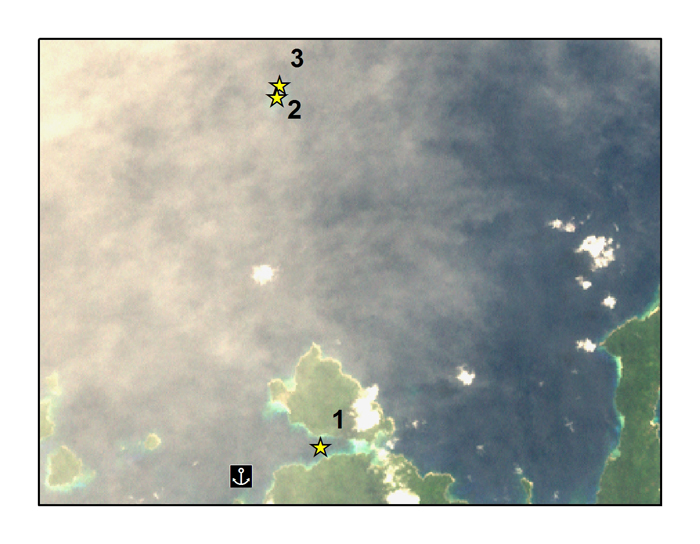
| Semut (28th November 2006) | N | E | satellite image |
| SV Infinity's anchorage | 03° 22.8402' | 106° 15.7902' | |
| Coral ridge in channel Selat Onas | 03° 23.1750' | 106° 16.6728' | 1 |
Tokongbelayar reef crest at edge of drop off |
03° 27.2154' | 106° 16.2204' | 3 |
| Tokongbelayar reef close to island | 03° 27.0822' | 106° 16.1940' | 2 |

Expeditions
SV Infinity was anchored just north of Pulau Baru. From here, we conducted
two snorkeling expeditions to the uninhabited island of Semut, through Selat
Onas (the channel running between Semut and Matak with coral reef formations)
and to Tokongbelayar (small rock island with fringing reef about 2 nautical
miles offshore from Semut).
Island observations
The island of Semut belongs to Conoco Phillips who have a base for their
offshore oil operations on the neighboring island of Matak. We landed on the
beach on the S/SW side where there is a small mooring to tie off. The beach
is soft white sand with some coral rubble. There were clumps of oil washed up
on the beach (also observed at Penjalin) plus a lot of trash on the beach and
on the seabed in the shallows. There is a coconut grove and some mangrove areas
edge the shore. We heard a bird which had an owl-like call and saw a white-bellied
sea eagle. On several of the beaches in Semut we found flour sacks filled with
sand. We observed in Terempah a week later sand bags being unloaded at the main
dock. It is used primarily in cement construction.
A path leads across the island to a beach on the NE side which is also soft
sand with corals growing all the way up to the shoreline. It takes about 7 minutes
to walk across the island. There is a large rock which has ‘Conoco Phillips’
carved into it. There is a recently poured cement area, either a helicopter
pad or a foundation, about halfway along the path crossing the island.
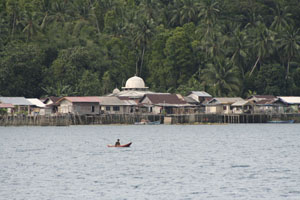
Reef observations
On the reef fringing
the south SW side of Semut we snorkeled in the shallows where we found patches
of hard coral on a sand substrate. There is a high presence of filamentous algae.
There are some branching Acropora spp. colonies plus some rubble and
dead coral. There are fields of Porites spp. fingers which looked like
they had been broken apart in the past; large boulder colonies split to create
canyons between them about 2 meters deep. (Photo to right: Selat Matak Channel)
Selat Onas is a narrow channel running between Semut and Matak (see photo
below). It becomes
increasingly shallow towards the east until it is
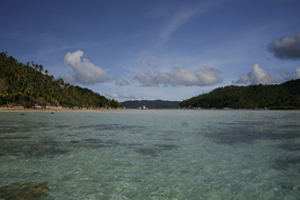 about 20 cm deep with a sand
bottom, impassable by zodiac at low tide. There are reef patches fringing the
south side of Semut and one very interesting ridge of reef which spans the width
of the channel. This ridge has large areas of foliaceous Montipora
spp. and branching and table Acropora spp. colonies. Both genera were
damaged by crown of thorns seastars. There was also evidence of dynamite fishing
but it did not appear to be recent damage; areas of broken corals and a significant
presence of macroalgae
about 20 cm deep with a sand
bottom, impassable by zodiac at low tide. There are reef patches fringing the
south side of Semut and one very interesting ridge of reef which spans the width
of the channel. This ridge has large areas of foliaceous Montipora
spp. and branching and table Acropora spp. colonies. Both genera were
damaged by crown of thorns seastars. There was also evidence of dynamite fishing
but it did not appear to be recent damage; areas of broken corals and a significant
presence of macroalgae
At Tokongbelayar, there were about 15 fishing boats less than a mile off the island, trawling with a hand line. While snorkeling we sighted four blacktip reef sharks. One of them was particularly lively, swimming very fast and decisively beneath us. The reef around the rock comprises a dense population of small coral colonies with small table Acropora spp. colonies dominating and generally in a healthy condition. There is some macroalgae between the colonies. We observed one small Acropora spp. colony which was completely white, possibly bleached or recently predated by crown of thorns. There is a long shelf extending northwards from the island before it drops off.
Turtle observations
We sighted two turtles while snorkeling in the Selat Onas, both too far
away to be identified.
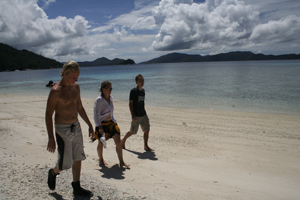
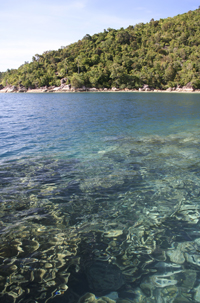
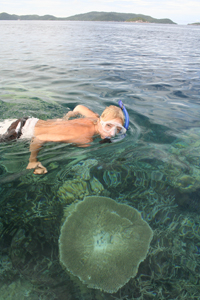
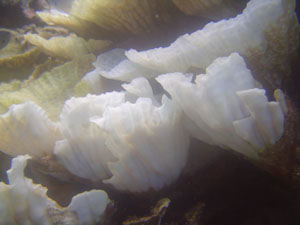
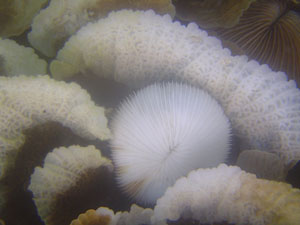
crown of thorns damage on Montipora spp. and Fungia spp.
colonies on the ridge in Selat Onas
page1 page 2 page 3 page 4 page 5 page 6 page 7 conclusion